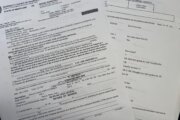It took U.S. track and field athlete Noah Lyles just 9.79 seconds to run 100 meters on Aug. 4. But it took the Olympic judges 29.47 seconds to confirm Lyles won the race by five-thousandths of a second.
In a similar fashion, investors have actively deliberated in recent weeks on how much — and when — the Fed will cut interest rates this year. On Aug. 29, rate traders signaled a 65.5% probability that the Fed would lower rates by 25 basis points, to a target range of 5% to 5.25%, at its policy meeting in September. The market was pricing in a 34.5% chance of a half-point rate cut, according to the CME FedWatch tool.
That’s quite a shift from July 9, when investors anticipated only a 3% probability of a half-point cut. Officials from the Fed, so far, have not signaled a cut of that magnitude in September, so it remains to be seen which investors’ expectations are on point.
[Sign up for stock news with our Invested newsletter.]
A Pivotal Moment for Bond Investors
Still, the Fed recently confirmed a willingness to pare back rates sooner rather than later. At an economic symposium in Jackson Hole, Wyoming, on Aug. 23, Chair Jerome Powell said, “The time has come for policy to adjust. The direction of travel is clear, and the timing and pace of rate cuts will depend on incoming data, the evolving outlook and the balance of risks.”
Rebecca Venter, senior fixed income product manager at Vanguard, says, “While inflation did surprise to the upside in the first quarter, it began to resume its downward path toward target in the second quarter. This, combined with softening labor market data, has given the market confidence that the Fed’s next move will be to cut rates.”
So, will bonds revive when interest rates start to fall? Here’s what you need to know about a rate cut’s implications for bond return, meaning an investment’s gain or loss, and also bond yield, which is the income earned on an investment. Remember that bond price and bond yield have an inverse relationship: As bond yields (and interest rates) go down, bond prices tend to go up.
— What’s the rate trajectory for the next few years?
— Are bonds about to bounce back?
— How today’s bond yields help predict future returns.
— What’s the longer-term forecast for bond returns?
— What does a bond turnaround mean for retirees?
What’s the Rate Trajectory for the Next Few Years?
Looking out over the next couple of years, the Federal Reserve Bank of St. Louis currently projects a median fed funds rate of 4.1 in 2025 and 3.1 in 2026. The median for 2024 is 5.1.
Rate trajectory carries a special meaning for many bond investors because it often signals potential price and yield movement. For many bond investors who have patiently endured 11 rate hikes since March 17, 2022, along with the worst-ever, double-digit drawdown in 2022, any rate cuts from the Fed would be welcome news.
Are Bonds About to Bounce Back?
Recent data from Hartford Funds and Bloomberg appear to make the case for a bond comeback. For example, within just 12 months following the last five rate-hike cycles since 1995, intermediate bonds have bounced back by an average of 11.55%.
Perhaps that’s why taxable-bond mutual funds and exchange-traded funds accounted for 90% of net U.S. fund inflows in the first half of 2024, according to Morningstar. “Investors are trying to lock in higher yields before they begin falling. Declining rates should also help bonds start to deliver positive returns after several years of negative returns,” says Steve Dean, chief investment officer at Compound Planning.
How Today’s Bond Yields Help Predict Future Returns
While cash flow and growth rates are often generative for the stock market, simple math is what drives the bond market. For example, Morningstar estimates the starting yield for a bond is 90% predictive of its returns in the following five to 10 years.
Pimco’s chief investment officer, Daniel Ivascyn, spoke at length on this topic in a recent episode of Morningstar’s “The Long View” podcast: “Fixed income is a less complicated segment of the financial markets than many other areas. The starting yield in a high-quality bond portfolio is usually a very reasonable floor as to what you’ll earn over a five-year holding period. If you have a high-quality (bond) portfolio earning 5%, 6%, 7% over the next five years, you have a very good shot of earning at least 5%, 6%, 7%.”
Kenneth Potts, senior vice president and portfolio manager for the U.S. Fixed Income team at Fiera Capital, adds that the “current environment of higher yields will generate more income from bond investments and higher return expectations. While bond returns can vary year to year, over the long term yields can be a reasonable guide for return expectations.”
What’s the Longer-Term Forecast for Bond Returns?
Currently, Vanguard estimates the 10-year return outlook for U.S. bonds at an annualized 4.5% to 5.5%. “Bonds present compelling potential returns today,” Vanguard’s Venter says.
“In Vanguard’s analysis, we estimate forward 10-year bond returns to be competitive with equities but, importantly, with only about a third of the volatility,” she adds. “As such, bonds today present an attractive opportunity for investors looking to further diversify and balance their portfolios.”
What Does a Bond Turnaround Mean for Retirees?
That’s especially good news for long-term investors who want to retire in the next five to 10 years, and for current retirees who need a steady stream of competitive income.
It also signals to investors who need an estimated long-term return of, say, 6% to 7% that the generally less volatile side of their portfolios, bonds, can potentially do a lot of the heavy lifting they’ll need in the coming years to keep their financial plan on track.
After all, it’s not a 100-meter sprint; it’s a marathon.
More from U.S. News
7 of the Best Fidelity Bond Funds to Buy for Steady Income
7 of the Best High-Yield Bond Funds to Buy Now
7 Best Treasury ETFs to Buy Now
Bonds and Rates: Will Bonds Revive as Rates Fall? originally appeared on usnews.com







